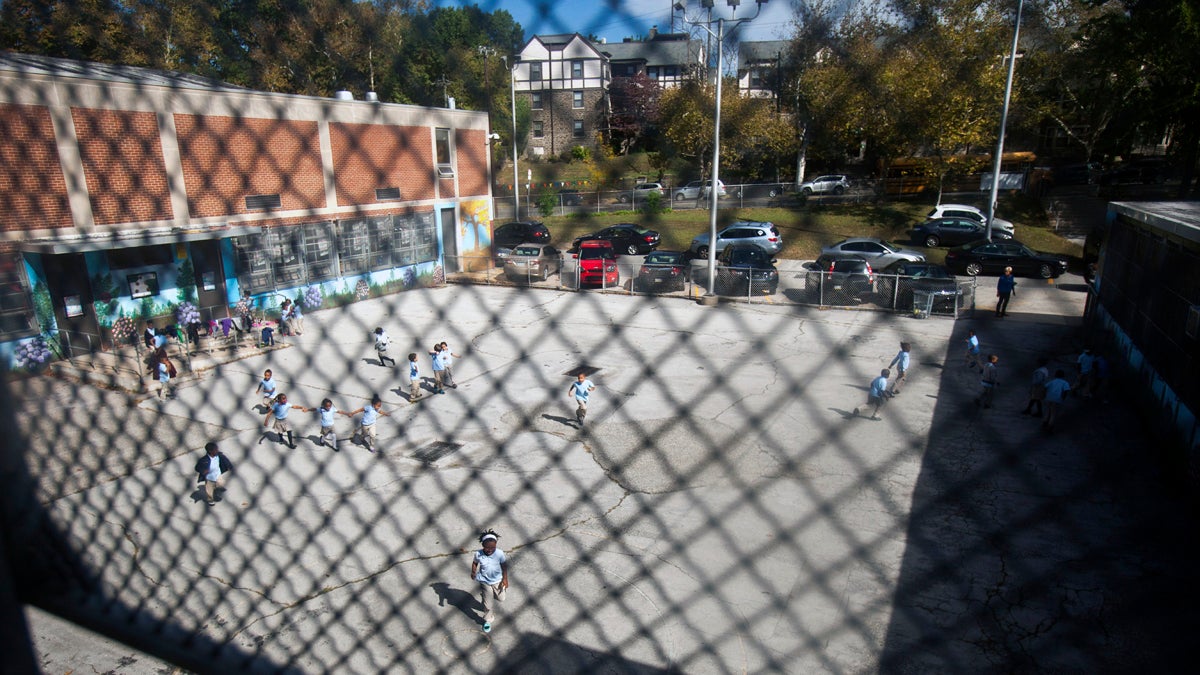What is a millage rate and how does it affect school funding?

Students play in a bare lot with asphalt patches during recess at Anna Lane Lingelbach Elementary School in Philadelphia. (Photograph by Jessica Kourkounis)
Millage is a relatively obscure term that represents the tax rate levied on real estate or other property. A mill is one thousandth of a dollar, or one tenth of one cent.
Tenth in an occasional series of podcasts and web “explainers.”
What is a millage rate?
Millage is a relatively obscure term that represents the tax rate levied on real estate or other property. A mill is one thousandth of a dollar, or one tenth of one cent.
The millage rate is the number of dollars of tax assessed for each $1,000 of property value. A rate of 10 mills means that $10 in tax is levied on every $1,000 in assessed value.
A school district typically will set the millage rate each spring as it calculates what it needs to fund its final budget. Some years, the rate stays the same; other years, there’s an increase.
What else goes into setting my tax bill?
The other key figure is the assessed valuation.
Every property has one. It is set by each county in Pennsylvania. But in many counties, the assessed valuations are not updated systematically on any set schedule.
When property values rise, this means the assessed value can lag behind what the house might sell for in the current year. It can even be far less if the value of real estate in the area has spiked and assessments aren’t updated, as happened in the first decade of this century in some gentrifying neighborhoods in and around Center City Philadelphia.
On the opposite side, in some cities and boroughs of Pennsylvania, where housing prices are stagnant or even falling, the assessed value and sale price may be about the same. Since most counties set the theoretical assessed value at some percentage of market value, this means a lot of properties in older boroughs and cities may be overtaxed.
Whoa, this is complicated. Some examples, please
Sure, here you go:
Take a house in Delaware County with an assessed value of $160,000, in a school district where the local school board has set the real estate tax rate at 20 mills. The homeowner’s tax bill would be $3,200 for the year –- 20 mills for each $1,000 of value, or 20 multiplied by 160.
Then imagine another district in the county where the real estate is only half as valuable. But reacting to its less wealthy tax base, the school board sets the tax rate twice as high: 40 mills. So a house assessed at $80,000 would generate the same tax bill: $3,200 for the year (40 times 80). But the owners of that cheaper house might have less wealth to handle the same tax payment.
Finally, imagine a house in school district which has a lot of office parks and a bustling mall. The house is assessed at $160,000, too, but because the district has a robust commercial tax base, it can pay its bills by setting a lower tax rate of 10 mills. So the annual school tax bill would be half that of the other two examples: $1,600 a year (160 times 10).
So are schools the only ones setting millage rates?
No. Other government entities –- the county, the local municipality and a few others – also raise revenues by taxing real estate through millage rates. But almost everywhere in Pennsylvania, the school tax bill is the biggest portion of your overall real estate taxes, followed by the municipality, with the county tax being the smallest.
In Philadelphia, a portion of the millage from real estate taxes is earmarked for the School District, and a slightly smaller portion goes to the city.
How much one mill raises in a district is determined by the district’s total wealth in assessed property value. The size of the district and the relative value of the property both come into play.
In the Multiple Choices podcast, Keystone Crossroads senior education writer Kevin McCorry joins with Paul Socolar, publisher and editor of the Public School Notebook, and Notebook contributing editor Dale Mezzacappa to explain and explore the history, complexities and controversies of public education funding in Pennsylvania.
Look for new installments of Multiple Choices every week for the rest of the spring, as the General Assembly reviews Gov. Wolf’s ambitious school funding and tax plan.
WHYY is your source for fact-based, in-depth journalism and information. As a nonprofit organization, we rely on financial support from readers like you. Please give today.



